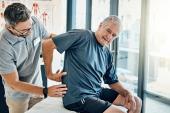‘Hot’ Doc? Radiation Exposure Risks of Interventionalists Aired in TV Special
The stories of radiation- and lead-related injuries and illnesses are important for younger cardiologists to hear, those involved say.

Photo credit: The Procedure, LLC
In just a few short decades, the field of interventional cardiology has led to groundbreaking treatments for patients with cardiovascular and structural heart disease. But the radiation that helps operators guide their wires and place stents, not to mention the heavy lead they must don, has resulted in injury, illness, and shortened careers for many passionate physicians, a new documentary details.
Scattered Denial, which began airing this summer on PBS stations around the United States, tells the stories of these interventionalists, and while the concerns are not new, those involved say they hope the program sounds a siren within the field: protect itself in order to be sustainable.
“We have worried about the conditions in factories like GM, Chrysler, and Ford Motors. If [they] had this kind of workplace injury and did so little to protect the workers, they would be shut down,” said David Rizik, MD (HonorHealth, Scottsdale, AZ).
The documentary is Rizik’s passion project: a 2-year journey to speak with operators across the United States, from well-known faces like Society for Cardiovascular Angiography & Interventions (SCAI) president James B. Hermiller, MD, who needed emergency back surgery, to physicians who have no hair on the left side of their bodies due to close proximity to the radiation source while working. Some overcame their injuries and illnesses with time. Others were not so lucky.
Rizik estimates that over a 20-year career, a cath lab worker may have had the equivalent of 20,000 chest X-rays to the head and neck.
“Every time we step in to save a life, we are exposing ourselves to potential harmful effects of ionizing radiation,” he said. “But it’s easy to overlook the dangers when presented with sick patients and when physicians are young and laser-focused on improving their procedural skills.”
In the documentary, Robert Foster, MD (Birmingham Heart Clinic, AL), says taking radiation badges off was commonplace in his younger years despite knowing that working in a cath lab presents the greatest risk of radiation exposure of all medical specialties.
Many times honestly we take our badges off because we know we’re going to exceed those limits, and our passion is to be in the cath lab. Robert Foster
Also in the documentary, filmed before his death, Edward B. Diethrich, MD, who founded the Arizona Heart Institute, says he considered himself “indestructible” when it came to radiation, adding, “Obviously, I didn’t know what I was talking about, did I?” As TCTMD reported, Diethrich died in 2017 from an oligodendroglioma brain tumor widely believed to have been the result of years of radiation exposure in the cath lab. While he admitted that the scientific evidence definitively tying excessive occupational radiation exposure to tissue damage is lacking, Diethrich remained convinced that his career and his cancer were closely related.
“It’s absolutely difficult to prove,” Rizik noted. “There's just so many Individuals who've developed these tumors, but we haven't studied it. It's essentially become anecdotal . . . because our professional obsession has not been workplace safety.”
Skin Cancers and Back Problems
To TCTMD, Rizik said while the stories in the documentary are painful and personal for everyone involved, he believes they are also crucial for younger interventional cardiologists to hear and heed.
John T. Eagan Jr, MD (Cardiovascular Associates, Birmingham, AL), says he experienced years of skin cancers on the left side of his body, including his head and neck, that were initially attributed to sun exposure. He continued to work in the cath lab like his father had done, doing 10 to 20 procedures every day. He says he attempted to use as much radiation protection as possible, “but sometimes it wasn’t practical to use complete protection in trying to take care of very sick, acutely ill cardiac patients.” The basal cell carcinomas became relentlessly frequent and by the age of 50 he had reached a point where he was needing to see a dermatologist almost daily due to new left-sided lesions.
Eagan ultimately had no choice but to leave his interventional practice to avoid further radiation exposure that he was told could be life-threatening. The abrupt shift in his career path was jarring, leaving him questioning if he could ever practice again. In time, he made the switch over to noninvasive cardiology and is at peace with the decision.
“In the cath lab, you really aren’t taught about where the radiation comes from . . . you wear your badge and it’s being monitored, but many times honestly we take our badges off because we know we’re going to exceed those limits, and our passion is to be in the cath lab,” said Foster.
He added that one of the unknowns about cath lab radiation exposure is not knowing how your body is going to react to cumulative exposure, likening the situation to patients with smoking histories who have normal arteries while others have been ravaged by their cigarette exposure.
“The cancer problem is real in that one in 25 of us will probably die of a radiation-induced cancer,” he said. A life-long runner, Foster experienced a ruptured disc in his back, which his orthopedic surgeon felt was from his 15 years of wearing heavy lead in the lab. Unwilling to give up his career at that point, Foster thought cutting back on his running might be enough to ease the strain on his back. Four years later, the disc ruptured again, paralyzing his right leg and leaving him unable to walk for about a month. This time, he made the decision to leave the cath lab for the sake of his health and his family.
Women, Cancer, and Pregnancy
Many people interviewed for the documentary said they received little to no training in radiation safety. Some like Aimee Armstrong, MD (Nationwide Children's Hospital, Columbus, OH), said they felt compelled to follow their mentors’ actions, many of whom didn’t like lead shields because “they got in the way” of doing their job.
In 2021, Armstrong was diagnosed with breast cancer despite having no family history of it and despite a recent normal mammogram. The tumor was in her left breast, leaving her to wonder if gaps in her lead vest at the armpit could have played a role in cumulative radiation exposure and tumor formation. As with Diethrich and others in the documentary, the source of Armstrong’s cancer remains an open question and a strong motivator for her to advocate for changes in the field that protect everyone.
You can be pregnant in the lab, and if you take appropriate protective measures, you can have a safe pregnancy. Celina Yong
Radiation concerns are often blamed for influencing the gender breakdown in interventional cardiology. In the United States, only 4.5% of interventional cardiologists are female, according to data from the National Cardiovascular Data Registry. In a survey of over 500 general cardiology fellows published in 2019, Celina Yong, MD, MBA (VA Palo Alto Healthcare System, CA), and colleagues found that men were significantly more interested than women in seeking a career in interventional cardiology. Looking further at those differences, they found that among other things, women were much more concerned than men about radiation exposure risk during their childbearing years. A primary motivator for women to choose the field was the presence of a female mentor or role model.
“When you look at the numbers, interventional cardiology ranks at the bottom in terms of gender representation compared to almost every field in medicine,” Yong told TCTMD. During her own training, she said she felt particularly uncertain about the topic of pregnancy while working in the lab and noted that there were few helpful data or mentors who could offer advice. A 2017 survey by the American College of Cardiology’s Women in Cardiology (WIC) section illustrated the disconnect, showing that despite expressing concerns about radiation exposure during pregnancy, only about 20% of female interventional cardiologists reported using fetal badges during a pregnancy and only 24% used additional lead.
Yong said one of her first projects as an attending was creating a curriculum around this topic and making it a required lecture for trainees.
She had her first pregnancy while a general cardiology fellow, her second as an interventional cardiology fellow, and her third as an attending working in the cath lab every day, and she said it’s important that radiation safety for pregnant cardiologists and those planning pregnancies be a topic for everyone in the specialty, not only to ensure safety, but also to grow the field and enrich it with talented women.
“You can be pregnant in the lab, and if you take appropriate protective measures, you can have a safe pregnancy,” Yong said. She added that stories like those shared in the documentary by primarily senior interventionalists who have been in the field for decades are important for younger cardiologists to hear and “are inextricably tied to our efforts to improve diversity in the field and to provide better care for our patients.”
Toward a More Stable Workforce
For Rizik, these stories and so many others in the documentary Illustrate the impact that their day-to-day work hazard has had on themselves and their families for decades.
“How we have addressed it hasn't changed in 40 years. The lead apron we wear has not changed in all that time,” he said. “When [National Football League] owners were advised of the need to make changes to equipment and sideline changes, they did it to protect their athletes. We've done so little. Why is it that doctors are the exception to the rule in terms of workplace safety?”
Every time we step in to save a life, we are exposing ourselves to potential harmful effects of ionizing radiation. David Rizik
Looking back, Rizik said there can be no doubt that the interventional cardiology field has made great strides for patients, yet it is littered with tragedy for many physicians. Armstrong, who developed breast cancer, was supported through her diagnosis and treatment by her good friend Kanishka Ratnayaka, MD, a pioneer in pediatric interventional cardiac MRI. Ratnayaka died in 2021 of cancer in his 40s. Like some others in the documentary, Armstrong has high hopes that one day, low-field MRI scanning will eliminate the need for X-ray in cardiac catheterization.
Foster, despite switching to general cardiology after his ruptured discs, wasn’t ready to completely give up on the field that had been his passion. With collaborators, he helped design an adjustable, portable radiation shielding system (Rampart; Rampart ic) that protects interventionalists and their technicians without requiring them to wear lead. The shield has allowed Foster to return to doing the procedures he loves and has created a sense that it is time to “switch from personal protection to community protection.”
Other novel shielding systems are entering the market and offering a way to dramatically change cath lab safety dynamics. Earlier this year, Rizik presented data at CRT 2024 on a comprehensive radiation shield (Protego; Image Diagnostics) that cut radiation exposure to primary operators during coronary and structural heart procedures by more than 99% when used in combination with standard safety measures.
Rizik said getting operators to the point of being lead-free is the goal to avoid illness and injury as well as to prolong their ability to do their jobs.
“People who have been in the cath lab for 20, 30, 40 years have seen how this problem has affected themselves and their colleagues,” he said. “Potentially the interventional cardiologist is going to have a shortened career because of this. In talking to people around the country, I also found that many had sought psychiatric care because of needing to leave the cardiac catheterization laboratory.”
In a recent editorial in JSCAI, Rizik called the need for zero radiation in the cath lab a “moral imperative” as opposed to an aspirational goal.
“The more-senior interventional cardiologists who you see in this documentary have really seized this opportunity to tell their stories and the consequences they have suffered. I think it is incumbent on us to create a safer workplace for the next generations,” he said. “The solution is awareness and involvement from all stakeholders.”
Rizik and others in the documentary acknowledge that cost is a stumbling block, with hospital systems charged with buying the shielding systems and configuring labs around them.
“Ultimately, I think it will be a recruitment tool and it'll create greater job satisfaction and a happier work environment,” Rizik said. “The bottom line is we have to protect employees, and if we do that, we will create a more stable workforce.”
L.A. McKeown is a Senior Medical Journalist for TCTMD, the Section Editor of CV Team Forum, and Senior Medical…
Read Full Bio




Comments